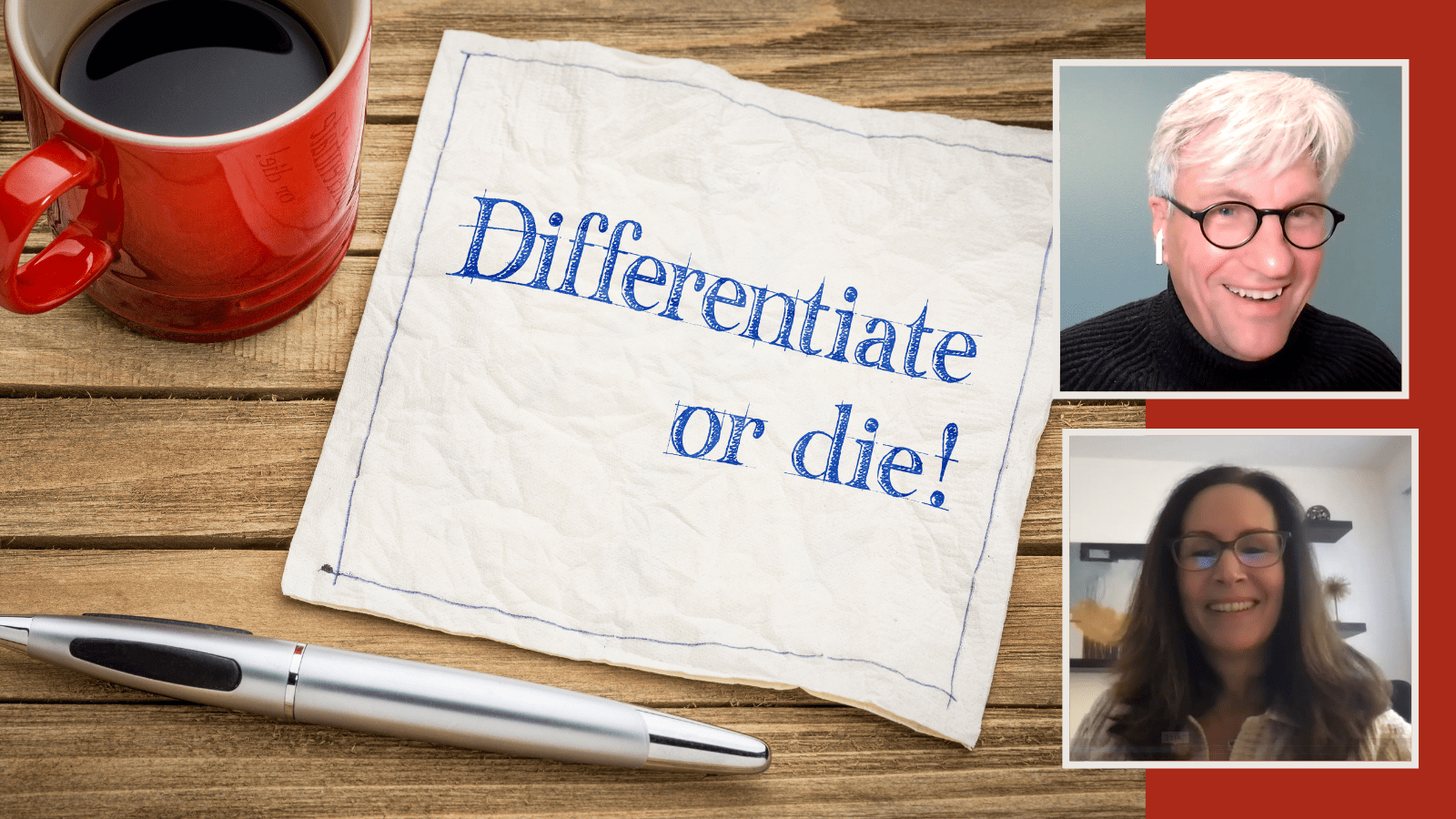It seems you can’t view a LinkedIn post or listen to a podcast these days without some reference to buyer-centric or customer-centric marketing. It’s the catchphrase of the moment; indeed, of the past several years. As marketers, we all strive to give our target audience what they want, right?
Yet why do I so often receive communications from companies selling their wares that lead with product or solution messaging? Product pitches are about THEM, not ME! It’s one of the great ironies of our times.
As I thought about how I could help companies solve this conundrum, I reached out to one of my favorite positioning experts, Bob Wright – managing director at Firebrick Consulting – for guidance. He generously agreed to share what he knows over a coffee chat. So I decided to invite a few hundred other marketers to join us!
Watch the full session here and see the highlights below.
Are we thinking big enough?
If you check out Bob’s profile on LinkedIn, you’ll see that he calls himself a “Possibilitarian”. It’s a lofty label, for sure, but appropriate when you consider the way he looks at the art of positioning. His goal for clients is to create a positioning story that’s big enough for the company to live into. Bob says he knows he’s done his job when the executive team (at the client company) says in response to proposed new positioning: “I guess we could be that.” Meaning: that the company is at the edge of itself….you’d still recognize the company at its core, but the vision is large enough for the company to aspire to.
I think so many of us, myself included, tend to anchor our view of positioning in what our company is today – including the buyers and customers we have now – than in what the company could be and will be.
Good Positioning = Storytelling
What do companies that have established themselves as leaders in their respective categories – such as Salesforce, VMware, Calendly, GitLab, and Chainlink – all have in common? Bob contends that all these enterprises have great positioning strategies.
As any seasoned marketing or company leader reading this knows, positioning pertains to your ability to sway consumer perception about your products, services, or brand relative to the competition. When executed right, positioning helps your company and brand thrive – enabling you to command premium pricing, lead your category, and ultimately drive a higher valuation.
However, traditional positioning strategies where brands start with their product’s features, price, and capabilities don’t work anymore. By contrast, the positioning tactics employed by market-leading companies are successful because they deviated from the standard positioning approaches.
“They all have stories, stories that have a viewpoint,” said Bob. “These companies don’t lead with their product features and functions they have.”
Bob stressed that positioning strategies that focus on buyers, their problems, and their needs, is now the way to go moving forward. Today, successful positioning is about storytelling.
Five Hard Truths
(6:44-8:57 in the recording)
Storytelling – sounds easy, right? However, before you get too excited and decide to jump in and start overhauling your positioning strategy, Bob notes that there are five hard truths you must first acknowledge and accept:
- No company wants another tech vendor. Executive buyers, in particular, feel like their organization has all the technology they need to operate and achieve desired results. They aren’t open to new technologies, thus, don’t want to hear from a tech vendor.
- Executive buyers don’t care how your product works. When executive buyers don’t have a need for your product, they won’t give it their time and attention. You need to communicate the “why”.
- The superior product rarely wins. Positioning, when executed right, can help lesser products dominate their categories and beat out superior products.
- Most companies are organized for yesterday’s buyers. Forward-looking companies tend to be more successful because they look at the next set of buyers, not at their current or previous customers.
- Positioning is not a marketing-only initiative. A positioning exercise should include active support and buy-in at the leadership level, particularly the CEO. My friend Udi Ledergor, CMO of Gong, shared a similar sentiment during our 2021 discussion on building your brand. Positioning should be sponsored by the top but marketing should manage it, making it a cross-functional activity.
“If you get positioning right, it can be the North Star for your company,’ said Bob. “Positioning can fuel your marketing investments.”
Buyers Want Problems Solved
For Bob, a good positioning story in the modern B2B marketing landscape is built on this simple question:
“What’s the big hairy problem you solve for your buyer?”
He then broke this down to three additional questions. The success of any positioning effort lies in how well the story answers these questions when you imagine a prospect is asking them:
- Why your product, why now?
- What are the unique capabilities that allow you to uniquely solve my problem?
- How are you going to make my life better?
Looking at the questions, Bob pointed out that the positioning is all centered on the buyer, their needs, their problems. This is a crucial key to achieving category leadership in a saturated market: “There is no conversation here about how the product works. Again, it’s all about why you matter.”
Seven Successful Principles for Building Category Leadership
So, in concrete terms, how do you create a buyer-centric – rather than a product-centric – positioning story? For Bob, the following seven principles should help you make the shift.
1. Fortune 500 or SMB is not a market.
One of the biggest mistakes B2B companies make, says Bob, is targeting companies using outdated segmentation techniques. Bob emphasized that “Fortune 500” and “SMB” are not markets and B2B marketers should concentrate their attention on the businesses that need their products.
Accuracy in targeting market segmentation is crucial to positioning success.
“The more precise you can get your positioning on the market segmentation size and the buyer, the stronger your position is going to be.”
2. Who are your target buyers?
It’s vital for B2B marketers to identify specific individuals that have the final say as well as influencers that can sway decisions. It may sound complex, but it all boils down to one person.
“The problem with B2B tech is that we have multiple buyers and influencers and sales cycles. So again, it’s not as black and white as this, but generally, it’s about determining the one person that if they said ‘yes’, and everybody else said ‘no’, they’d still go with your solution.”
3. Own a big, strategic multi-million-dollar problem.
“Every significant technology company, every significant category leader owns a multi-million-dollar problem, Bob pointed out.”
It’s imperative for B2B companies to demonstrate a big problem that only their product or tech can solve. The key to owning that problem is articulating it to potential B2B buyers in a way they can understand and appreciate.
4. Have a strong viewpoint and follow through.
It’s also important for B2B companies to take a stand on important issues and actually walk the talk. Consumers expect brands to be champions and advocates of prevailing causes and issues like diversity, social equality, environmental sustainability, and more.
Taking a stand is an effective way of standing out from the competition. More importantly, enterprises must be able to connect their stand to that multi-million-dollar problem they solve.
5. Make the fight about your unique IP.
This is where you connect your customer’s multi-million dollar problem to what you actually do. What do you want to make the fight about, and why does it matter? Part of building your position after taking a stand is to make the case or argument that only your technology and product have the capabilities to solve their critical and immediate pain points in addition to addressing what’s ahead.
6. Take a corner of the room.
Assert your organization’s position by making a clear distinction about your brand, what you do that your competitors don’t. Highlight features and capabilities that you have, the problems that you can address, and other things that elevate your brand over the competition.
“If you and all the other competitors are bunched in the middle of the room, what’s the buyer going to do?” asked Bob. “If they can’t tell the difference between you and anybody else, they’re not going to make a decision, or they’re going to go with the brand name company.”
7. Take your buyers on a journey.
Help your buyers manage their expectations by providing them a clear picture of how your product or technology will evolve and how this evolution will impact them.
“In the old days of B2B tech, a lot of companies got in trouble because they were selling vision and could never deliver on it,” said Bob. “It’s really important to properly manage the expectations about what your solution or product can deliver today, but can also lay the groundwork for the future.”
Lean Back and Watch the Entire Discussion
Want to hear more, straight from the horse’s mouth? Watch the complete webinar here.
Got more questions? Message Bob directly via LinkedIn. I also invite you to connect with me and share what topics you’d like for us to explore in the future.
Lisa Ames is Norwest’s CMO and Operating Executive. She leverages her more than 20 years of B2B SaaS marketing experience working shoulder-to-shoulder with portfolio companies to help them thrive.


